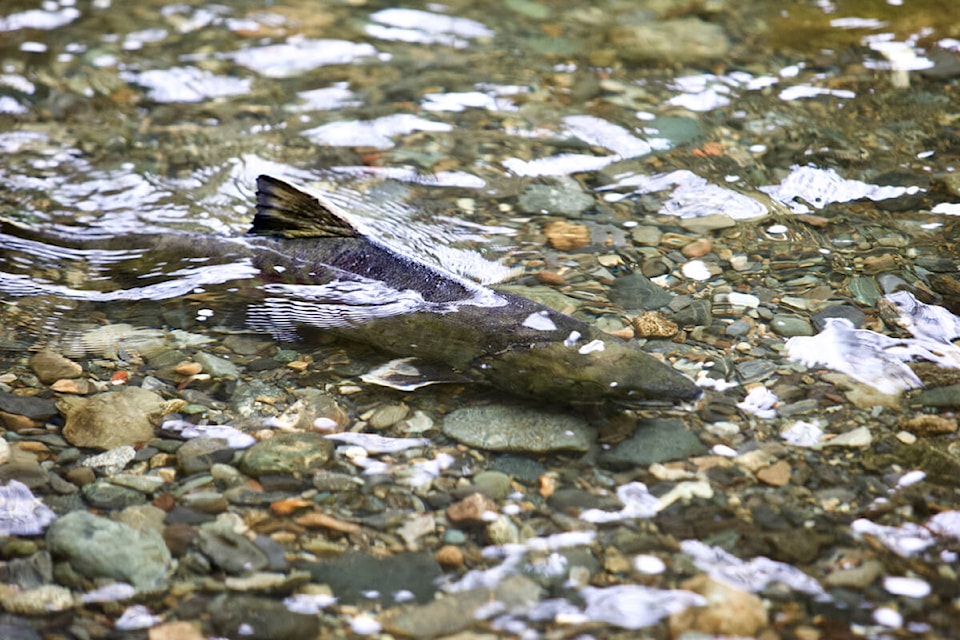A devastatingly low chum salmon return at Goldstream Park is rippling damage across restoration projects
The return was, at best, one-tenth of the anticipated numbers said Peter McCully, a technical advisor for the volunteer-run Goldstream Hatchery who also works with the Department of Fisheries and Oceans.
The lowest anticipated return of chum salmon was in the 22,000 to 23,000 range.
“At best there may have been about 3,000,” McCully said. “It’s the worst return I have seen and I have been involved with the Goldstream Hatchery since 1975.”
This year’s remarkably low return even beats out 2021, when 20,000 chum were predicted to return to the river. Instead, it saw about 4,000. The next year Goldstream saw the salmon return nearly double its target – with an estimated more than 30,000 chum.
READ ALSO: Goldstream Hatchery salmon program hit hard by ‘perfect storm’
“It’s not the end of the line for chum salmon, they’ve adapted to come back as three, four-, five- or sometimes six-year-old fish,” McCully said. “If it’s repeated next year and the year after that we’re in serious shape. It’s not a happy picture.”
While he can’t conclude he feels several recent weather events may have had an impact.
Those factors include serious flooding in 2020 and the atmospheric river of 2021. Those events scour river bottoms and churn the gravel stirring up the fertilized eggs and killing them, he said. Then there was the heat dome of 2021.
“We have a situation the last few years where sea surface temperatures have been a lot higher than they normally are, and it’s this upper portion of the sea that produces the food these little salmon rely on when they go out to sea,” he said.
READ ALSO: Goldstream River salmon run doubles target, fortunes mixed elsewhere
The local waterway is not alone, the low 2023 chum returns span the coast of B.C. into Alaska, he said.
“(Chum) are the ones that draw the crowds and they’re the ones the Goldstream is famous for,” McCully said. “These runs support so many creatures and flora and fauna … the ripple effect is huge.”
Usually, the Goldstream Hatchery team is able to harvest and fertilize eggs to support community salmon return initiatives in waterways such as Bowker Creek; Lyall Creek on Saturna Island; Hope Bay Stream on Pender Island; Douglas (PKOLS) Creek in Saanich and Wsikem (Tseycum) Creek on the Saanich Peninsula. They’re among several small creeks that have lost their salmon because of urban development – for example, significant portions of Bowker Creek are paved over – and in the case of Wsikem historical airport activities.
“We’ve been able to provide eggs to all those initiatives … this is the first year we won’t,” McCully said. “We normally take 400,000 to 500,000 chum eggs. This year we got 5,000. It’s just a disaster.”
RELATED: Volunteers pack 36K chum salmon eggs into Oak Bay creek
Each of the past two years, Friends of Bowker Creek received more than 30,000 eggs to place in its streamed incubator as part of its salmon recovery project.
While it’s unfortunate that cycle will be interrupted, they have other important work to keep them busy, society chair Gerald Harris said.
“We now have to keep getting ready for next year which we’re actually still doing,” he said. “We’re in the process of constructing some new incubation boxes that wouldn’t have been ready for this year anyway. So we’re taking it as a regrettable little setback and we’re confident in continued support from the DFO.”
They’re “oddly excited” about the new endeavour. The new incubation boxes are a remarkably different design from the single gravel site in the stream bed used previously.
VIDEO: Oak Bay fry emerge, swim to Salish Sea in bid to bring salmon back to Bowker Creek
In use elsewhere on the Island, the new boxes are smaller and rather than being buried in the gravel, sit on top. With the successful work creating shoreline safe spaces. The prior work in the shoreline riparian area provides a few good sites for the smaller boxes, Harris said.
“That’s what’s allowing us to move into a different approach to egg incubation because there are now good little spots along the creek where we can nestle in smaller incubation boxes that will use existing habitat.”
Volunteers also plan to do in-stream work, to create optimal habitat for fry.
“We’re understanding again more than we did before that these little fry are not as likely as we thought to just come out of the gravel and just shoot down the stream,” Harris said, adding fry may hang out for two weeks to a month. “In that time they need to be protected from our voracious Bowker Creek mallards … plus other predators that pretty quickly find out there are new little defenceless fish in the creek.”
VIDEO: Oak Bay society shares thrill of finding fish fry swimming in Bowker
Despite the low chum return, some fry will make their way into streams up and down the Island, as the Goldstream Hatchery team did harvest and fertilize enough chum eggs to support its massive classroom program. The hatchery provides small batches of eggs to about 100 classroom incubators for students to learn while hatching their fry. Kids subsequently release surviving fry into their local creeks each spring.



